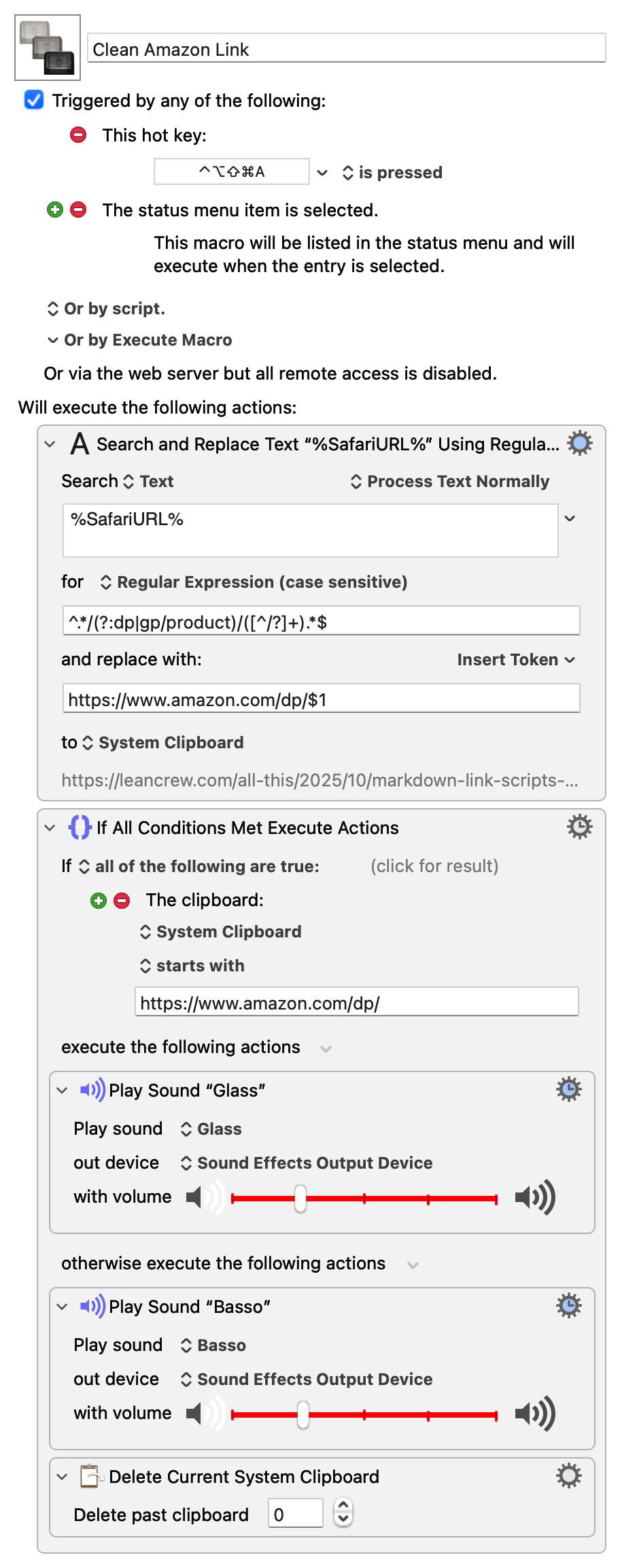Clean Amazon links
October 18, 2025 at 10:06 AM by Dr. Drang
A footnote in last night’s post mentioned that the Amazon links therein had been cleaned of cruft. Today, I’ll show the simple automated way I do that.
When I say “cruft,” I mean the unnecessary additions to the URL that are presumably used by Amazon to benefit Amazon rather than you. For example, I just went to Amazon, searched for “homepod,” and clicked the link for a refurbished HomePod mini. This is the URL:
https://www.amazon.com/Apple-HomePod-mini-Black-Renewed/dp/
B0FK8JL74Q/ref=mpsa12?dib=eyJ2IjoiMSJ9.
okyLqpx2YKuwgWlCBKI2sx5DMA0QRhm1CnQPmA4KRzU8prbSTnXdAbE97fG0
tEwplRuboB2VvY5O6X6RZlvBK-MDyqaDNPwuqLUtqglS2gVwxITbCrE-
A5JKngZ9MmPHgucGCJSduRY0Ap3RUqVJy42OrYI9eh-
GcIQn52Fj7NgpN2pv3jyeZBvnCXsUcbFhTREmb2NV66tKI0ccT4OUg.4yYkD
-bBpGy0yyNVWMQnH8ZirFh3NhnFov0B0BZDIQ&dib_tag=se&keywords=
homepod&qid=1760794983&sr=8-2
I’ve added line breaks to make it easier (sort of) to read. I got this using Vivaldi, a browser I downloaded to my phone a while ago but haven’t used to visit Amazon before. It was definitely not signed into my Amazon account. Even so, I wouldn’t be surprised to learn that some part of this monstrous string is tied to me and my current session at Amazon.
Regardless, virtually none of this URL is needed. The key features are the dp at the end of the first line and the alphanumeric string that starts the second line. That string is the product’s ASIN. This simplified URL,
https://www.amazon.com/dp/B0FK8JL74Q
is enough to get to the product page. To go from the long URL to the shorter one, I use this Keyboard Maestro macro:

There’s not much to it. It grabs the URL of the current Safari page1 and puts it on the clipboard. It then does a search-and-replace on the clipboard using this regular expression for searching:
^.*/(?:dp|gp/product)/([^/?]+).*$
Over the years, I’ve noticed that some URLs have the ASIN after gp/product instead of dp, which is why you see the alternative there in the first set of parentheses. The ?: that follows the opening parenthesis means that this is a non-capturing group. What is captured is the ASIN that follows, which is why you see $1 at the end of the replacement regex:
https://www.amazon.com/dp/$1
The last part of the macro is a simple bit of error handling. I’ve noticed that I sometimes run this macro when I’m not on an Amazon page, which would put a URL I don’t want on the clipboard. So this checks the clipboard for the proper form. If it’s right, the Glass sound plays; if it’s wrong, the Basso sound plays and the clipboard goes back to what it was before.
If you download the macro (right click the link so you can save it with a .kmmacros extension) and import it into Keyboard Maestro, it will appear in the Global Macro Group and will be activated. I have it in the Global group because I sometimes use it in Messages or Mail to keep the URL I’m sending short. It’s not just for writing posts.
I should mention that I wrote about a very similar TextExpander abbreviation a decade ago. In that post, I had TextExpander run JavaScript for Automation to get and simplify the URL. I was also somewhat dismissive of using Keyboard Maestro—which I didn’t own back then—for a task like this. Times have certainly changed.
-
Yes, the long URL is from Vivaldi, not Safari, but I had the same product page open in Safari. The short URL is the same for both because the
dp/B0FK8JL74Qpart of the long URL is the same for both. ↩
